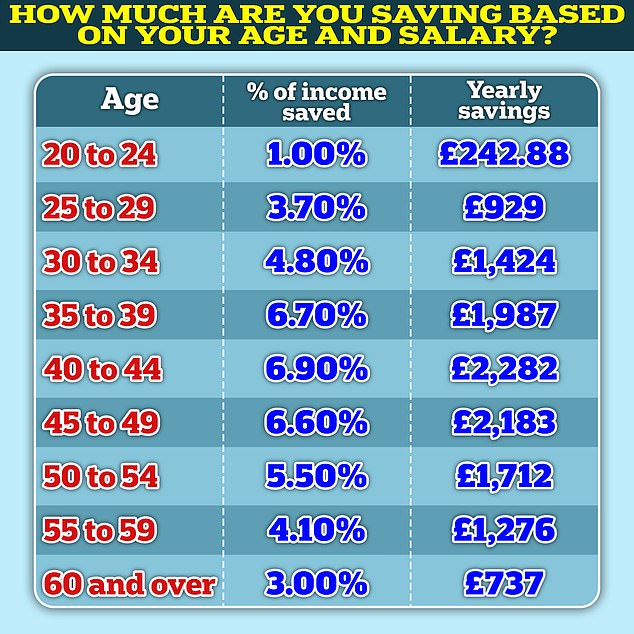Table of Contents
Savers are still managing to save money despite two years of high inflation, rising food and energy costs and rising mortgage or rent payments.
But how much do people save each year and how does that change depending on what stage of life they are in?
More than half of 25- to 29-year-olds are setting aside 3.7 per cent of their annual income for the future, a new report from investment platform Hargreaves Lansdown suggests.

How much do you save? New figures show that younger generations manage to save almost 4% of their income each year.
The average annual salary for this age group is around £30,000, according to ONS figures.
Those aged 25 to 29 who earn around £2,000 a month after tax save 3.7 per cent of their earnings, saving around £75 a month.
In the age group of 35 to 39 years, 64 percent of households manage to save some money and save on average 6.7 percent of their annual income.
The average annual salary for this age group is £36,320 according to ONS figures, so after tax this age group manages to save £1,987 a year, or £165 a month.
People between 40 and 44 years old have savings equal to 6.9 percent of their annual income.
With an average salary of around £41,000 after tax, this age group could save £2,279 a year or £189 a month.
Savings rates peak at age 40, according to Hargreaves Lansdowne. This is also the case for the average annual salary, which fell to £38,368 among those aged 50 to 59.
It’s enough?
Personal finance experts recommend keeping three to six months of household expenses as an emergency fund.
It should be enough to cover rent or mortgage payments, utility bills, food and childcare, and should be kept in an account that you can access at any time should circumstances change.
Despite being able to save some money, it is evident that younger generations lag behind their older counterparts when it comes to the amount they save, saving much less as a percentage of income than other age groups.
If a 25-year-old earning an average salary of £2,000 a month after tax saved 3.7 per cent of their income, that would equate to £75 a month.
Even if they had been doing this for a couple of years, they would have only saved £1,959, leaving them with less than a month’s salary to rely on if they had a financial emergency.
Emma Wall, head of investment research and analysis at Hargreaves Lansdown, said: “We recognize the pressures on younger people (rising rents and bills, student debt, inflation), so savings levels that this cohort is still managing to acquire is impressive.
‘Yes, it is lower than other age groups, but that is not unexpected. The important thing is that, as far as possible, people develop their resilience over time, so that when life’s obstacles come, they are better equipped to deal with them.’
Those who participated in the HL Savings and Resilience Barometer research are the “heads of the family”, which for the youngest means that they live independently, not with their parents.
Those still in the family home will likely be able to accumulate more emergency funds.
The percentage of people who have no extra money at the end of each month almost doubled between 2022 and 2023, Nationwide Building Society findings suggest.
The percentage of households that had no cash left at the end of the month increased from 11 percent in 2022 to 21 percent in 2023.
More than one in five, or 22 per cent, of households have less than £100 left over at the end of the month, compared to just 13 per cent in 2021, Nationwide said.


Resilience: Those who have enough money in an emergency fund might consider investing or saving in a fixed-rate account to help achieve their long-term financial goals.
Savings and investment tips to generate wealth
When it comes to wealth building and financial resilience, saving cash for emergency expenses and long-term investments are important and each has a role to play.
For those looking to build up a cash reserve, savers might consider putting their money in one of the best easy-access accounts. That way they can grow their emergency fund while earning a guaranteed rate of return.
At the moment, the best easy-access accounts pay more than 5 percent. Hampshire Trust Bank pays an interest rate of 5.06 per cent and can make deposits from just £1.
> Find the best purchase savings rates and easy access using our tables
After setting aside enough emergency savings, someone might consider investing to help them achieve their medium- and long-term financial goals, such as retirement.
Another option is to look into fixed-rate savings accounts, where you keep your money for a set period in exchange for a higher return.
Emma Wall says: ‘If you’re investing for the first time, avoid stock picking. Instead, look for broad market exposure, at a low cost, like an iShares ACWI ETF, invested in more than 2,000 companies in developed and emerging markets.
‘This is a great basic option for first-time investors, to which you can add satellite holdings that reflect your perspectives or interests. Note that this ETF invests in all stocks, which should offer better long-term returns than other asset classes, but can be volatile on the way there.
‘More cautious investors who are not comfortable with rebounds should opt for an opening with mixed bonds, for example Schroder Managed Balanced.
If you’re investing for the long term (to pay for your retirement adventures) and you’re employed, often the most sensible route is to simply maximize your workplace pension contributions.
“It’s literally free money, as you get top-ups from your employer and the government,” adds Wall.
Some links in this article may be affiliate links. If you click on them, we may earn a small commission. That helps us fund This Is Money and keep it free to use. We do not write articles to promote products. We do not allow any commercial relationship to affect our editorial independence.

